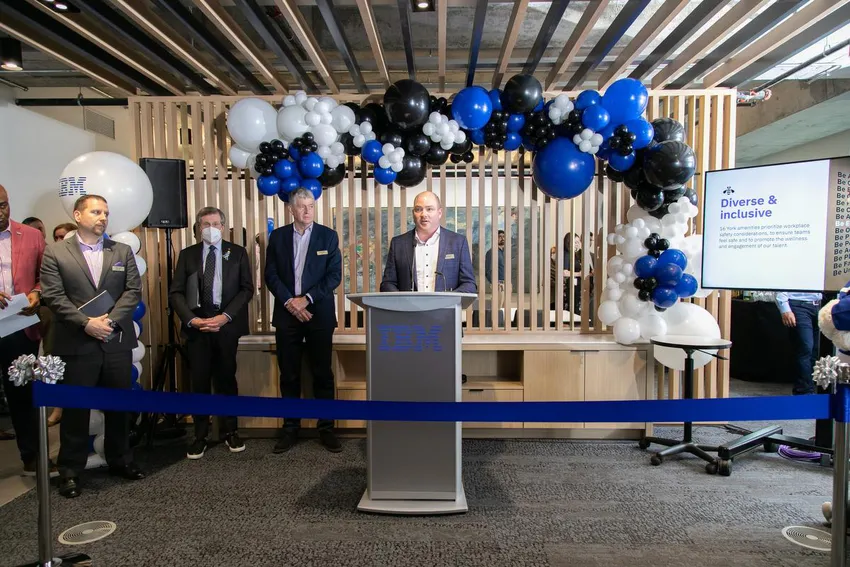When IBM unveiled Watsonx — a new artificial intelligence platform designed to make businesses more efficient — at its annual global forum in Orlando in early May, a mix of awe and apprehension spread across the auditorium.
Watsonx is the next iteration of IBM’s Watson, the AI computer system that handily beat “Jeopardy!” superstars Ken Jennings and Brad Rutter on the American game show in 2011 in front of an astonished crowd.
Watsonx is challenging human minds in a more subtle way, by facilitating everyday business processes. It can already monitor and moderate the temperature of buildings without requiring a maintenance worker, create sport highlight reels without the need for an editing professional, and provide customer service more efficiently than a human — for less money, and without ever losing its temper.
The unveiling came in the wake of IBM CEO Arvind Krishna estimating that the proliferation of these very AI technologies — making headlines since OpenAI’s ChatGPT permeated the mainstream last November — would lead to roughly 8,000 job cuts over the next five years in his own company’s global human resources department.
Essentially, IBM’s state-of-the-art creation, along with its competitors like ChatGPT and Google Bard, would render thousands of its own employees redundant, potentially putting them out of work.
But the New York-based computing giant’s top executives have a plan for those workers who fear being replaced by their company’s very own technology: its very own re-skilling program.
IBM SkillsBuild, which launched in 2020, is the company’s worldwide re-skilling program aimed at preparing 30 million people across five continents — who work at IBM and elsewhere — for jobs in fields like cybersecurity, data analytics, software engineering and information technology before the era of AI fully ushers in.
Dave McCann, president of IBM Canada, told the Star the re-skilling program — which offers free courses through 170 partner schools and institutions across the world — will provide an estimated 35,000 Canadians with skills that will allow them to participate in a rapidly evolving job economy, and better protect them from imminent layoffs.
“Our population is growing in Canada, and we need to find tech-driven solutions to also grow our job market and allow as many people as possible to contribute to a new economy,” says McCann, who has held his role since January 2022. “This shift in the marketplace presents a big re-skilling opportunity, one that we are moving toward with a thoughtful, human-first approach.”
The degree to which these systems will render traditional jobs obsolete is difficult to project, though the World Economic Forum predicted there will be 97 million jobs created and 85 million axed worldwide between 2020 and 2025 as the pivot toward automation shifts the division of labour between humans and machines. Just last year, a third of the respondents to a workforce survey fielded by accounting and professional services firm PwC said they were worried about the prospect of their role being replaced by technology as soon as 2025.
Keeping people gainfully employed as a growing number of jobs and processes become automated is quickly becoming one of the most pressing issues of our time: After all, what would happen to society if millions and millions of human jobs are rendered obsolete, almost all at once? While IBM advocates for re-skilling as a solution to mitigate the fallout of forthcoming layoffs, several experts the Star spoke to say re-skilling is often not effective and won’t solve the larger problem.
Frank Attaie, general manager of technology at IBM Canada, says he understands the worries workers have around a rapidly changing job market. But he stresses that IBM SkillsBuild’s courses, delivered in 19 languages and offered in full- and part-time formats, will help people whose roles fall out of favour find work. He said developing new skills could even create upward mobility for these workers; an office administrator who takes a course and becomes a level one technician, for example, would double their salary.
Attaie considers his own career an odyssey in re-skilling: his first jobs at IBM were with the organization’s personal computer and printing companies, which have both folded in lieu of new technologies.
“We’ve been re-skilling and shifting for a long time; IBM started at weight scales, cheese slicers and typewriters in the early 1900s,” he says. “We believe that people can evolve with technology, and we are willing to invest in those who want to re-skill.”
The AI challenge
Re-skilling is not new: emerging technologies have caused shifts in the marketplace since the beginning of work. Candlemakers had to retool when electricity nixed the demand for their product in the late nineteenth century, and farmers comprised half of our workforce until the Industrial Revolution reduced that number to two per cent.
As University of Toronto professor of strategic management Ajay Agrawal points out, those would-be-farmers are not jobless today — they have taken up new jobs, often in areas better suited for them, he says.
The unique challenge with AI, says Agrawal, is that it will touch nearly all fields and disciplines at once; Attaie of IBM predicted that 75 per cent of all businesses worldwide will use artificial intelligence in the coming years.
It is, in part, the very anticipation of such wide-ranging market changes that made uneasiness about AI technology reach fever pitch earlier this year, when an open letter calling for a six-month pause on AI technology, signed by more than 30,000 people including thought leaders like Elon Musk and Apple co-founder Steve Wozniak, circulated the internet.
“We haven’t seen a technology moving so quickly and hitting so many sectors at the same time,” says Agrawal. “It’s not obvious to me that this program and others can prepare all these people quickly enough.”
For that reason, he’s not overly optimistic about this new era of work, and says AI may not only necessitate the re-skilling of some, but also cause the deskilling of others. In London, he explains, aspiring cab drivers used to spend three years committing to memory the map of the city in preparation for an infamously difficult final navigation exam simply referred to as The Knowledge. Now, he says, anybody with a driver’s licence and Google Maps can get around just as well as the city’s top cabbie.
“People don’t study for The Knowledge anymore, kind of like people don’t study the times tables like we did 25 years ago — there is no need,” says Agrawal. “To that effect, ushering in AI technology might even the playing field, but I’m not sure what we will see more of: people learning new skills and earning more wages, or skilled workers seeing their wages and value go down because AI has automated what makes them special.”
The problem with re-skilling
Predicting what skills will make someone “special” and valuable in the next era of work, and therefore what is worth teaching, says Agrawal, can seem impossible to predict.
The World Economic Forum anticipated that, in 2025, top professions will include data and artificial intelligence, content creation and cloud computing.
Meanwhile, the top skills needed according to the Forum — analytical thinking, creativity and flexibility — are not likely taught in a re-skilling program, says Jim Stanford, economist and director at the Centre for Future Work.
Stanford, who calls IBM’s target of re-skilling 30 million people an “enormous and unprecedented vocational offering,” is dubious of education initiatives led by private companies.
“These courses might be valuable to particular people, but they also have to be valuable to the economy, and not super specialized micro-credentials that lose their merit as technology develops further,” says Stanford. “They certainly should be no substitute for a college or university education.”
For Ibukunoluwa Akinsola, an HR professional living in Richmond Hill who has been learning through IBM’s re-skilling program since 2021, SkillsBuild is not a replacement for a degree so much as a useful add-on to her resume.
She already holds a master’s degree in human resources management and seven years of work experience in her home country of Nigeria, but enrolled in courses in data analytics and Microsoft Excel to gain new abilities and grow her network.
“Through SkillsBuild, I have an IBM data analytics professional as a mentor, and it’s helped me get to know more about that world in Canada and to make connections.”
Akinsola, who is balancing her courses with a full-time job in human resources, says she is also learning these new abilities as a safeguard against potential layoffs in her industry.
“The future of work is more techy, and that’s what informed my entry into data analytics: I don’t not want my job to become redundant,” says Akinsola. “If you want to stay advanced in today’s world and economy, you have to keep upskilling, and you need flexible programs like this one to exist.”
Still, SkillsBuild and programs like it cannot be considered the antidote to the problems of tomorrow’s workforce, says U of T’s Agrawal. Especially, he says, if we find ourselves having to fill roles that are new and constantly evolving.
“In six months, we’ll know a bunch of things we don’t know today, so it’s impossible to take a strong position on how to prepare for what’s coming.”

